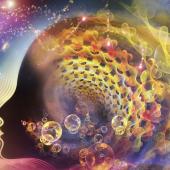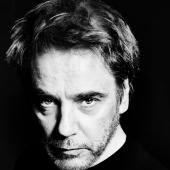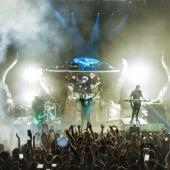Karlheinz Stockhausen
Karlheinz Stockhausen was one of the most important composers of the 20th century. He still is a pioneer and an important source of inspiration for a comprehensive artist circles. From Joseph Beuys over Kraftwerk up to the DJ's and artists of the techno generation all musicians who work with electronic music refer to the master of the artificially produced sound.
Stockhausen was born on 22nd August 1928 in Mödrath near Cologne. Even as a schoolchild his special musical talent showed in his piano playing. He studied after high school at the Cologne Music Academy and musicology, philosophy and German literature at the University of Cologne. Finally, around 1950, he began to compose.
At first his music was still dominated conventionally. But soon he turned to serialism and shaped the flow of the new music by developing the twelve-tone technique. So he was already assigned the role of a leading music theorist during his lifetime.
From 1963 to 1969 Stockhausen was the director of the Cologne Courses for New Music. Moreover, he worked internationally as a teacher. Originally coined Catholic, he increasingly turned towards Zen Buddhism in the late 60s which manifested the first time in his artwork "Stimmung" in 1968. Between 1953 and 1998 he worked closely with the Studio for Electronic Music of the West German Radio. As artistic director, he devoted himself more and more to electroacoustic music. A commitment that earned him the nickname "Godfather of the Techno Generation". The seven-part "Light Cycle” applies as his life's work, a total of 29 hours of total playing spread across seven days – it is the longest opera in music history. In this cycle Stockhausen aimed at the connection of scenic, visual, room acoustical and musical ideas into a single unit.
Stockhausen experimented with the construction of complex rhythmic structures by superimposing meters, similar to a sound composed of such sinusoidal tones. He also started to compose groups instead of points. So the new view was obtained that rhythmic statements do not relate to individual durations, but to speeds and frequencies of repeating events. He published these and other findings in the article “Wie die Zeit vergeht“.
After the completion of "Light" from 2004 on Stockhausen draw his attention to the "Sound". He considered the composition of "Sound" as the voice of conscience. With regards to "Sound" it is a cycle of concert pieces for one or more soloists, some with live electronics and a purely electronic composition. Through Stockhausen's sudden death in 2007, only 21 of the 24 projected parts of the work - which are assigned to the 24 hours of the day - could be completed.




